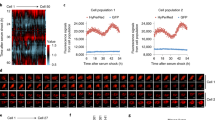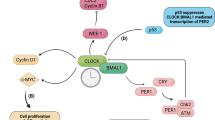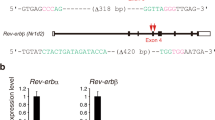Abstract
The circadian clock is the central timing system that controls numerous physiological processes. In mammals, one such process is haem biosynthesis, which the clock controls through regulation of the rate-limiting enzyme aminolevulinate synthase 1 (Alas1)1,2. Several members of the core clock mechanism are PAS domain proteins, one of which, neuronal PAS 2 (NPAS2), has a haem-binding motif3,4. Indeed, haem controls activity of the BMAL1–NPAS2 transcription complex in vitro by inhibiting DNA binding in response to carbon monoxide3. Here we show that haem differentially modulates expression of the mammalian Period genes mPer1 and mPer2 in vivo by a mechanism involving NPAS2 and mPER2. Further experiments show that mPER2 positively stimulates activity of the BMAL1–NPAS2 transcription complex and, in turn, NPAS2 transcriptionally regulates Alas1. Vitamin B12 and haem compete for binding to NPAS2 and mPER2, but they have opposite effects on mPer2 and mPer1 expression in vivo. Our data show that the circadian clock and haem biosynthesis are reciprocally regulated and suggest that porphyrin-containing molecules are potential targets for therapy of circadian disorders.
This is a preview of subscription content, access via your institution
Access options
Subscribe to this journal
Receive 51 print issues and online access
$199.00 per year
only $3.90 per issue
Buy this article
- Purchase on Springer Link
- Instant access to full article PDF
Prices may be subject to local taxes which are calculated during checkout




Similar content being viewed by others
References
Zheng, B. et al. Nonredundant roles of the mPer1 and mPer2 genes in the mammalian circadian clock. Cell 105, 683–941 (2001)
Panda, S. et al. Coordinated transcription of key pathways in the mouse by the circadian clock. Cell 109, 307–320 (2002)
Dioum, E. M. et al. NPAS2: a gas-responsive transcription factor. Science 298, 2385–2387 (2002)
Gilles-Gonzalez, M. A. & Gonzalez, G. Signal transduction by haem-containing PAS-domain proteins. J. Appl. Physiol. 96, 774–783 (2004)
Zheng, B. et al. The mPer2 gene encodes a functional component of the mammalian circadian clock. Nature 400, 169–173 (1999)
Yamaguchi, S. et al. Role of DBP in the circadian oscillatory mechanism. Mol. Cell. Biol. 13, 4773–4781 (2000)
Rutter, J., Reick, M., Wu, L. C. & McKnight, S. L. Regulation of clock and NPAS2 DNA binding by the redox state of NAD cofactors. Science 293, 510–514 (2001)
Yamaguchi, S. et al. The 5′ upstream region of mPer1 gene contains two promoters and is responsible for circadian oscillation. Curr. Biol. 10, 873–876 (2000)
Travnickova-Bendova, Z., Cermakian, N., Reppert, S. M. & Sassone-Corsi, P. Bimodal regulation of mPeriod promoters by CREB-dependent signaling and CLOCK/BMAL1 activity. Proc. Natl Acad. Sci. USA 99, 7728–7733 (2002)
Garcia, J. A. et al. Impaired cued and contextual memory in NPAS2-deficient mice. Science 288, 2226–2230 (2000)
Albrecht, U., Sun, Z. S., Eichele, G. & Lee, C. C. A differential response of two putative mammalian circadian regulators, mPer1 and mPer2, to light. Cell 91, 1055–1064 (1997)
Tsutsui, K. & Mueller, G. C. Affinity chromatography of haem-binding proteins: an improved method for the synthesis of hemin–agarose. Anal. Biochem. 121, 244–250 (1982)
Hashimoto, S. et al. Vitamin B12 enhances the phase-response of circadian melatonin rhythm to a single bright light exposure in humans. Neurosci. Lett. 220, 129–132 (1996)
Nakamura, T., Uchida, K., Moriguchi, Y., Okamoto, N. & Morita, Y. Transient fluctuation of serum melatonin rhythm is suppressed centrally by vitamin B12. Chronobiol. Int. 14, 549–560 (1997)
Hardin, P. E., Hall, J. C. & Rosbash, M. Feedback of the Drosophila period gene product on circadian cycling of its messenger RNA levels. Nature 343, 536–540 (1990)
Kume, K. et al. mCRY1 and mCRY2 are essential components of the negative limb of the circadian clock feedback loop. Cell 98, 193–205 (1999)
Shearman, L. P. et al. Interacting molecular loops in the mammalian circadian clock. Science 288, 1013–1039 (2000)
Tunctan, B. et al. Circadian variation of nitric oxide synthase activity in mouse tissue. Chronobiol. Int. 19, 393–404 (2002)
Artinian, L. R., Ding, J. M. & Gillette, M. U. Carbon monoxide and nitric oxide: interacting messengers in muscarinic signaling to the brain's circadian clock. Exp. Neurol. 171, 293–300 (2001)
Rubio, M. F., Agostino, P. V., Ferreyra, G. A. & Golombek, D. A. Circadian haem oxygenase activity in the hamster suprachiasmatic nuclei. Neurosci. Lett. 353, 9–12 (2003)
Fu, L., Pelicano, H., Liu, J., Huang, P. & Lee, C. C. The circadian gene Period2 plays an important role in tumor suppression and DNA damage response in vivo. Cell 111, 41–50 (2002)
Matsuo, T. et al. Control mechanism of the circadian clock for timing of cell division in vivo. Science 302, 255–259 (2003)
Zhu, Y., Lee, H. C. & Zhang, L. An examination of haem action in gene expression: haem and haem deficiency affect the expression of diverse genes in erythroid k562 and neuronal PC12 cells. DNA Cell Biol. 21, 333–346 (2002)
McLean, G. R. et al. Cobalamin analogues modulate the growth of leukemia cells in vitro. Cancer Res. 57, 4015–4022 (1997)
Levitman, M. K. et al. Antitumor effect of combined treatment with ionizing radiation and vitamin B12–C complex. Radiat. Biol. Radioecol. 42, 511–514 (2002)
Scagliotti, G. V. et al. Phase II study of pemetrexed with and without folic acid and vitamin B12 as front-line therapy in malignant pleural mesothelioma. J. Clin. Oncol. 21, 1556–1561 (2003)
Norman, P. Pemetrexed disodium (Eli Lilly). Curr. Opin. Invest. Drugs 2, 1611–1622 (2001)
Lincoln, D. W. II, Hrushesky, W. J. & Wood, P. A. Circadian organization of thymidylate synthase activity in normal tissues: a possible basis for 5-fluorouracil chronotherapeutic advantage. Int. J. Cancer. 88, 479–485 (2000)
Freedman, M. L., Geraghty, M. & Rosman, J. Hemin control of globin synthesis. Isolation of a hemin-reversible translational repressor from human mature erythrocytes. J. Biol. Chem. 249, 7290–7294 (1974)
Acknowledgements
We thank S. L. McKnight for the Npas2m/m mice and NPAS2 antibody; M. Reick for technical comments; H. Okamura for the mPer1–luc and Clock expression constructs, P. Sassone-Corsi for the mPer2–luc expression plasmid; Z. Sun for suggesting the use of haem–agarose; and P. Hastings, R. Kellems and J. Lever for comments. This work was supported, in part, by a grant from the NIH (to C.C.L.).
Author information
Authors and Affiliations
Corresponding author
Ethics declarations
Competing interests
The authors declare that they have no competing financial interests.
Supplementary information
Supplementary Figure 1
Synchronization of clock gene expression in NIH3T3 cells by haem. (PDF 1842 kb)
Supplementary Figure 2
a, Haem inhibits wheel-running activity during subjective night. b, Single-plotted wheel-running activity from mice injected at CT22. (PDF 4677 kb)
Supplementary Figure 3
NPAS2 and mPER2 mediate haem effects on mPer1 and mPer2 expression. (PDF 4813 kb)
Supplementary Figure 4
mPER1 is a minor regulator of NPAS2. (PDF 5068 kb)
Supplementary Figure 5
A model of reciprocal regulation between the circadian clock and haem biosynthesis. (PDF 4881 kb)
Supplementary Figure 6
c-Myc is regulated by NPAS2 and is modulated by haem. (PDF 3379 kb)
Legends for Supplementary Figures
c-Myc is regulated by NPAS2 and is modulated by haem. (DOC 25 kb)
Rights and permissions
About this article
Cite this article
Kaasik, K., Chi Lee, C. Reciprocal regulation of haem biosynthesis and the circadian clock in mammals. Nature 430, 467–471 (2004). https://doi.org/10.1038/nature02724
Received:
Accepted:
Issue Date:
DOI: https://doi.org/10.1038/nature02724
This article is cited by
-
Identification and characterization of a heme exporter from the MRP family in Drosophila melanogaster
BMC Biology (2022)
-
Timed use of digoxin prevents heart ischemia–reperfusion injury through a REV-ERBα–UPS signaling pathway
Nature Cardiovascular Research (2022)
-
Period1 mediates rhythmic metabolism of toxins by interacting with CYP2E1
Cell Death & Disease (2021)
-
Six degrees head-down tilt bed rest caused low-grade hemolysis: a prospective randomized clinical trial
npj Microgravity (2021)
-
MFSD7C switches mitochondrial ATP synthesis to thermogenesis in response to heme
Nature Communications (2020)
Comments
By submitting a comment you agree to abide by our Terms and Community Guidelines. If you find something abusive or that does not comply with our terms or guidelines please flag it as inappropriate.



